Measure campaign effectiveness: Track your KPIs and report on campaign performance
Measuring campaign effectiveness is an important consideration early in the planning stages of your campaigns. Knowing what metrics you need to track gives you the best chance of gaining valuable insights that can guide future campaigns, lead to more success down the line, and an improved ROI. Setting up these metrics in the Lexer CDXP will be an important step early in the process, so you can create audiences that will let you effectively measure your success.
In this article, we'll be using Lexer's Track tool to show you how you can measure campaign effectiveness in the CDXP. Before we get into the nitty gritty of this use case, do you know all you need to know? We have a great article on Learn that runs through all things Track. If you’ve read through this article and want more, you’re in the right place. Let’s get into it!
What are you trying to achieve?
First things first, what is the objective of your campaign? The purpose of the campaign will determine how you set up your Track dashboard and your metrics. You might be testing an offer, some messaging, a creative, or monitoring a spike in some of the following metrics:
- Sales/LTV
- Order volume
- Site activity
- Email events (open/click-through/unsubscribe)
- Subscribers or sign-ups
If you want some campaign inspiration from some of our other clients, we have some great client stories on lexer.io.
Audience splits
When you have a clear idea of what you want to achieve, the next step is to determine how to best measure it using your data. Thinking about how you structure your audiences will allow you to get the most out of your data. Audience splits are a great way to help you experiment with your creative and hone in on those customers that your campaign will really resonate with.
The two main types of audience split are:
A/B Splits (50:50 split)

Once you have chosen your target audience within the Hub, go to Engage to divide your selected audience in half, without bias, allowing you to test the effectiveness of two creatives on two very similar audiences. Whichever has a higher success rate wins and is the more effective creative, easy!
Control group splits (90:10 split)

The 90/10 split uses a similar principle to the A/B split, but splits a 10% group to use as a control group. This group will have no change compared to the 90% audience that will receive the new creative or messaging. Remember, both audiences in the A/B split could receive a new creative but this 10% control group will receive nothing.
Control group splits provide a great way to accurately show the true impact of a campaign, providing a great comparative tool. For example, your sales rose by 200% compared to the control, awesome!
🔥 Lexer tip 🔥
You may want to make sure your A/B tests aren’t impacted by other campaigns that could have audience crossover. When you run an audience split, by default, the audience is tagged with the activation name as an attribute “Included in Audience”. Let’s look at an example of how this can be carried out with an A/B split.
If you run a campaign targeting High Value (Top 50%) customers, the profiles included in this activation will have this campaign added to their profiles, as shown in the screenshot below. If they were part of the “B” group when using the A/B split, they will have “(B)” appended to this audience tag rather than the "(A)" you can see below.
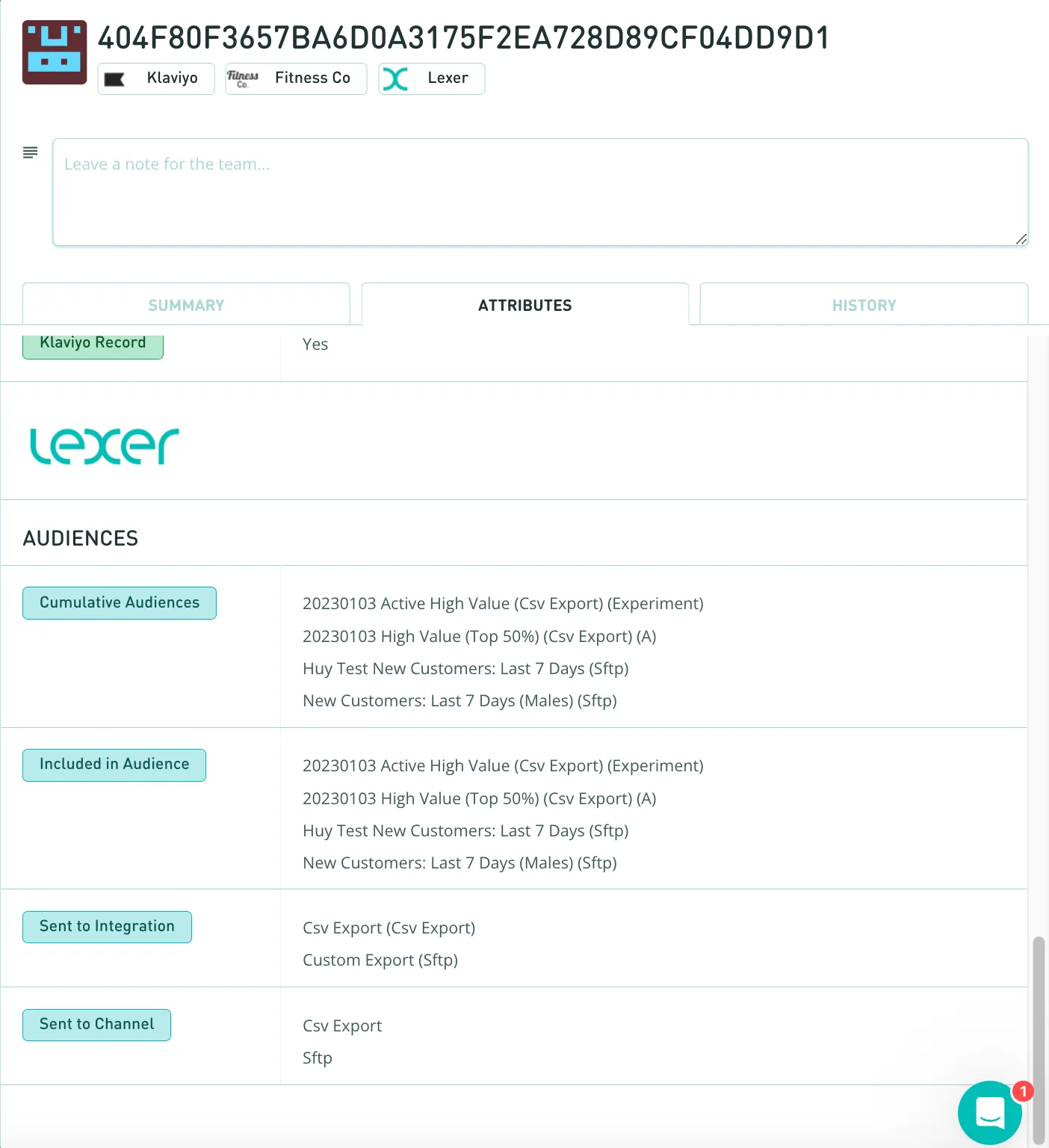
You can then create a segment that will include your (A) audience and exclude your (B) audience in the Segment Builder. Let’s look at how to do this in the Hub.
- Navigate to Understand > Segment.
- Add the Included in Audience attribute to the PROFILES MUST HAVE ALL OF THESE section of the builder and select the relevant audience from the drop down list. Our example is using the “20230103 High Value (Top 50% (Csv Export) (A)” audience. Once this has been added we need to remove the “B” group. To do this, add the Included in Audience attribute, this time selecting the “20230103 High Value (Top 50% (Csv Export) (B)” audience and dragging it to the BUT NOT HAVE ANY OF THESE section of the builder.

- Finally, click SAVE AS NEW SEGMENT on the bottom left of the Segment Builder and fill in the details. This segment has been named “High Value (Top 50%) Group A (excludes audience B) - 20230103”.
You can then use this segment to exclude this audience from activations, an example is shown below, easy peasy! If you need a refresher on Activate, have a look at our docs here.

Audiences are ready, let’s get your Track metrics set up
Now that you’ve completed your audience splits and have the audiences you want to use for your testing, you can set up your campaign segments. To set up your segments you can use the Included in Audience attribute (shown in the screenshot above).
This involves the same steps we covered to create the “High Value (Top 50%) Group A (excludes audience B) - 20230103” segment covered in the Lexer tip section above.
To quickly reiterate:
- Navigate to Understand > Segment. From here you can search in the Segment Builder for the Included in Audience attribute.
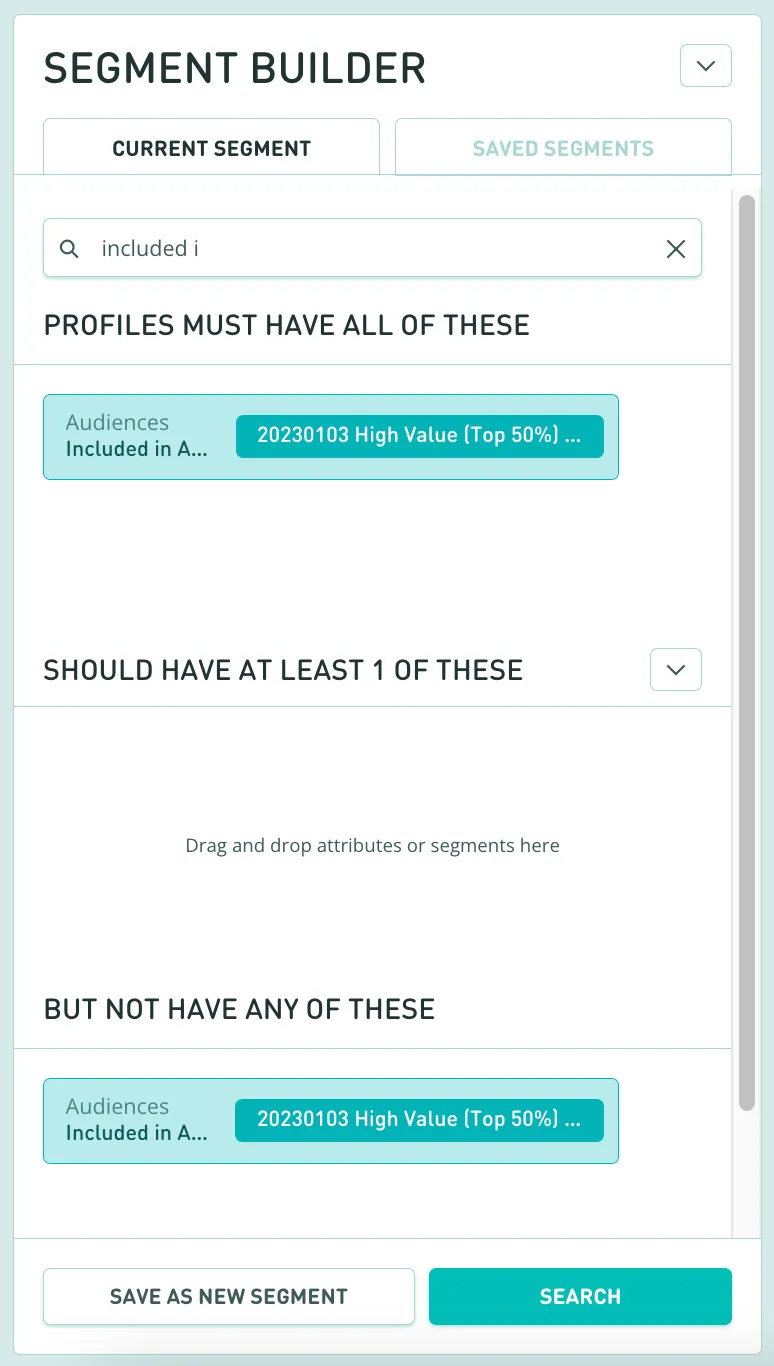
- Add the audience from the list that is relevant to the campaign you are activating. In this example the campaign used is “20230103 High Value (Top 50%) Csv Export) (A)”. You can also exclude the irrelevant audience, “20230103 High Value (Top 50%) Csv Export) (B)”. Once you are happy with your segment, save this as a new segment.
After the segments have been created, you can set-up your metrics for your Track dashboard.
- Navigate to Measure > Track.
- Click on the Metrics tab located on the left of the page, then TRACK ANOTHER METRIC at the bottom of the page.

- In the Segment search at the top of the METRICS SETTINGS, search for the segment you have created.
- Identify the attribute you would like to measure with this audience, then fill out the other required fields in the settings.
In our example here we're going to track the Total Spend for campaign segment X. To set this up, add the segment, “High Value (Top 50%) Group A (excludes audience B) - 20230103”, track the Total Spend attribute, in this case we have chosen to track this as a Sum. Once this is complete, finish filling out the details required for the Metric, give it a name, category, and Save.

You now have one Metric set up ready for your dashboard. Follow this process for the rest of the metrics you'd like to set up for each of your campaign segments.
Once this is done, you are ready to create a dashboard to track your KPIs before the campaign launches.
Use your Metrics to create a Track Dashboard
Simplicity is best for Track dashboards. Use metrics like Total Spend and Total Orders, inputting the dates of your campaign using the date picker, and compare between the two segments to see if there has been a lift in any number of useful metrics, for example, sales, orders, email opens, etc. You can then use these metrics to guide future creatives and if appropriate, make changes to a current campaign.
- To add a new dashboard, click on NEW DASHBOARD on the bottom left of the Track home page.

- The NEW DASHBOARD settings will then open up. Fill out these details with a name, category, and description.
- Once you have your new dashboard set up, you can drag and drop metrics into the dashboard.

As you review your Track dashboards, looking at the column titled delta, between the campaign start / end date, will help you determine the difference between the control group and your active audience.
Remember, a control group is used to provide a comparison, they will receive no new creative or messaging. This way you can compare the group that has received a new campaign with the control group. If there is a significant increase in the Total Spend delta of your active audience compared to that of your control, great news, your campaign is a success! If there isn't much difference between the audiences, your next similar campaign might need some careful consideration. You can see an example of this in the dashboard below.
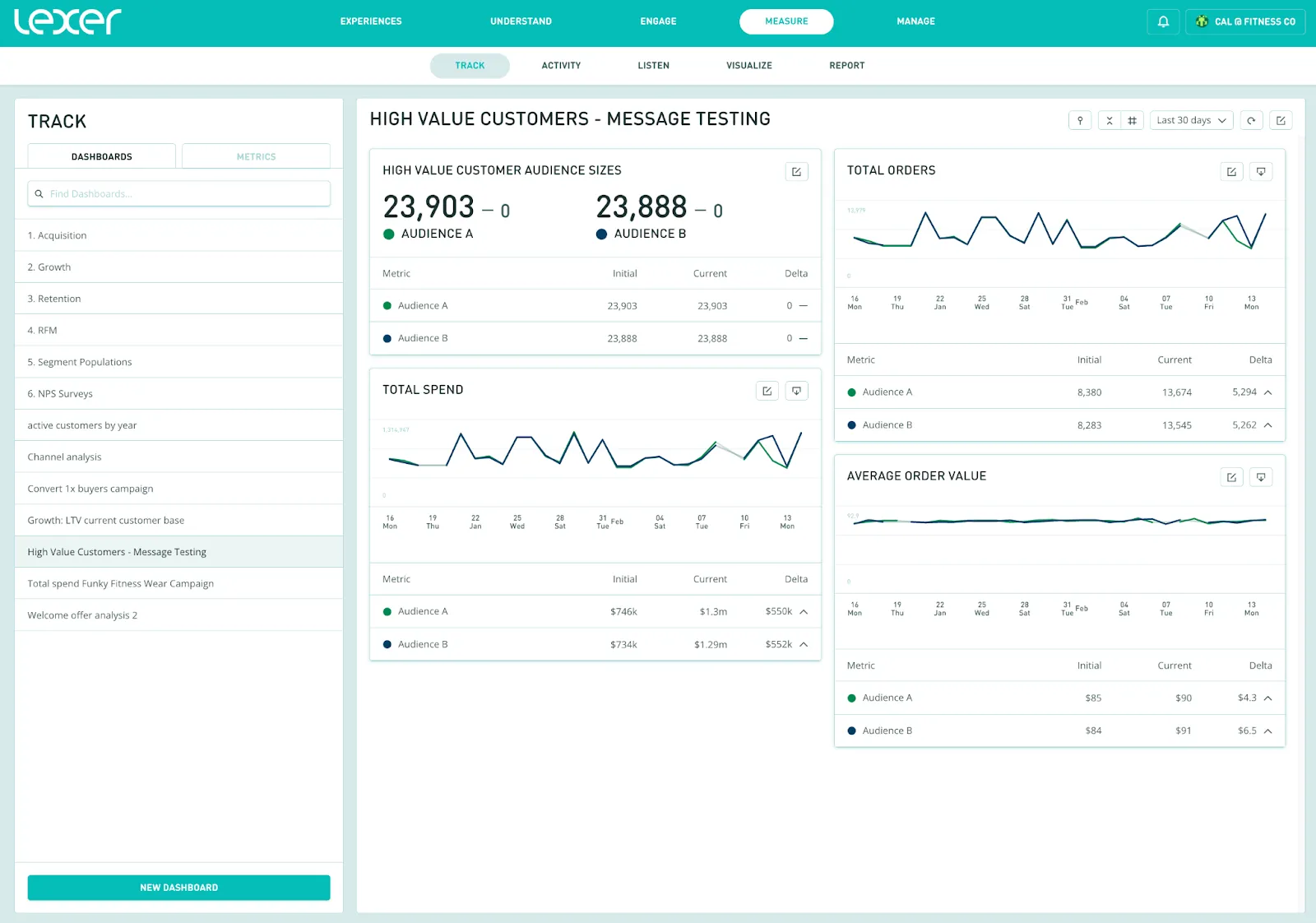
How can this help me make business decisions?
- Campaign attribution: How effective was the campaign? The track dashboards can help you understand, during the activation window (the period after sending the campaign in which customers are most likely to purchase eg. 5 days), how many customers have made a transaction.
You’ll need to choose an appropriate activation window, remembering the longer the window, the greater the opportunity for your metrics to be ‘tainted’ by other campaigns or activities running at the same time.
For example, you might want to see how many customers made a transaction in a 5 day period following the date that your email was sent. You can do this by creating a segment that includes two attributes in the PROFILES MUST HAVE ALL OF THESE section of the builder: the Included in Audience attribute, selecting the appropriate audience from the drop down, and the Order attribute with Order sequence - Last and Order Date - Last 5d.

From here you can create your metrics and add them to a dashboard to track changes after the campaign has been sent. This process was explained in the “Audiences are ready, let’s get your Track metrics set up” section of this article.
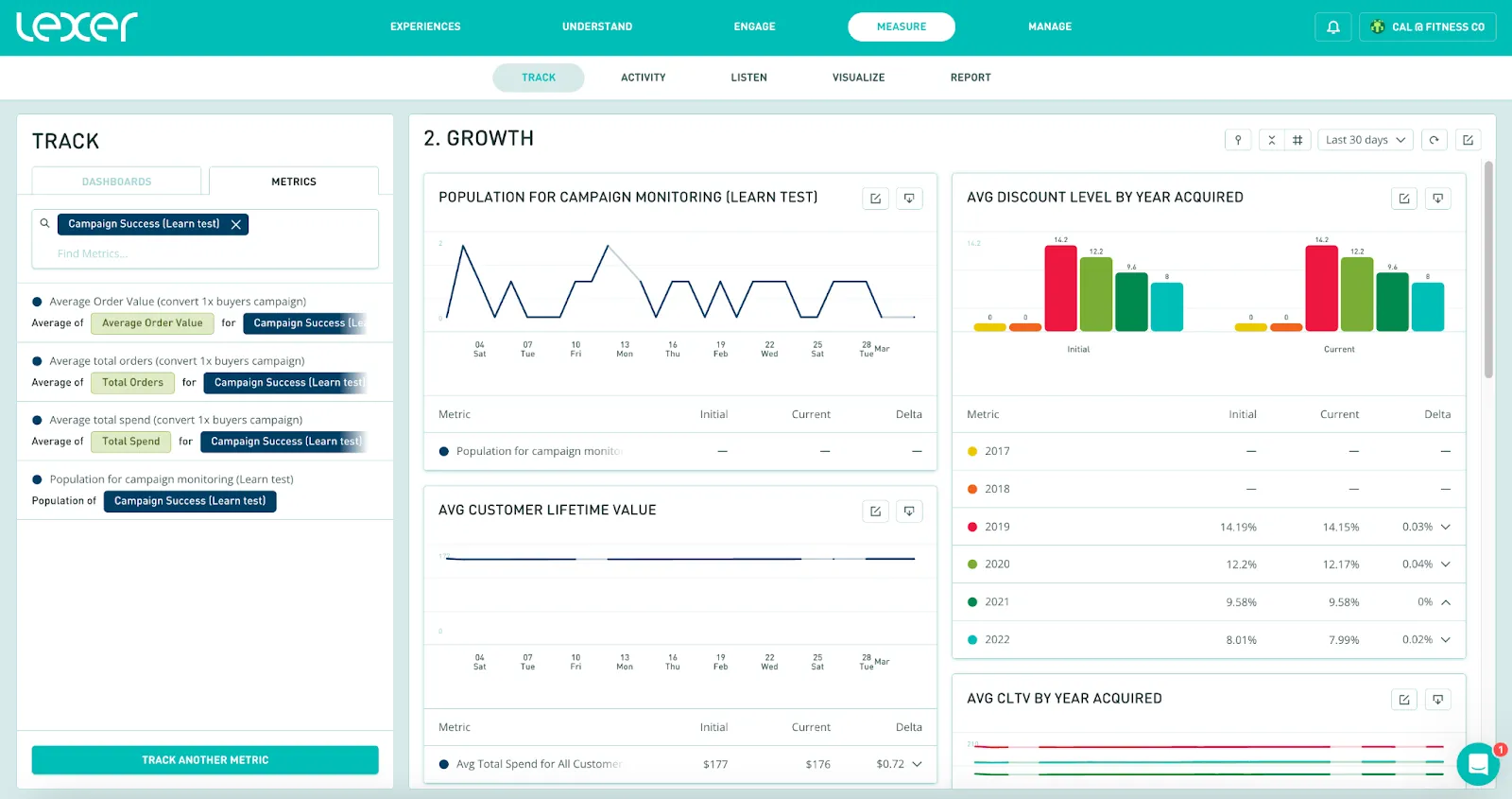
- Audience insight: Once you have activated your audience, you can measure the impact in the CDP and use metrics like average order value, total orders, number of items per order, Experian Group, product category etc. to determine whether your campaign was effective for specific customer groups. This information can help guide the audiences for your future campaigns.
For example, if we look at the Total Spend Funky Fitness Wear Campaign in our testing Hub we can see a great representation of some of these key metrics for our A and B audiences. You can use the date picker to look at the impact of this campaign over time on the two audiences.
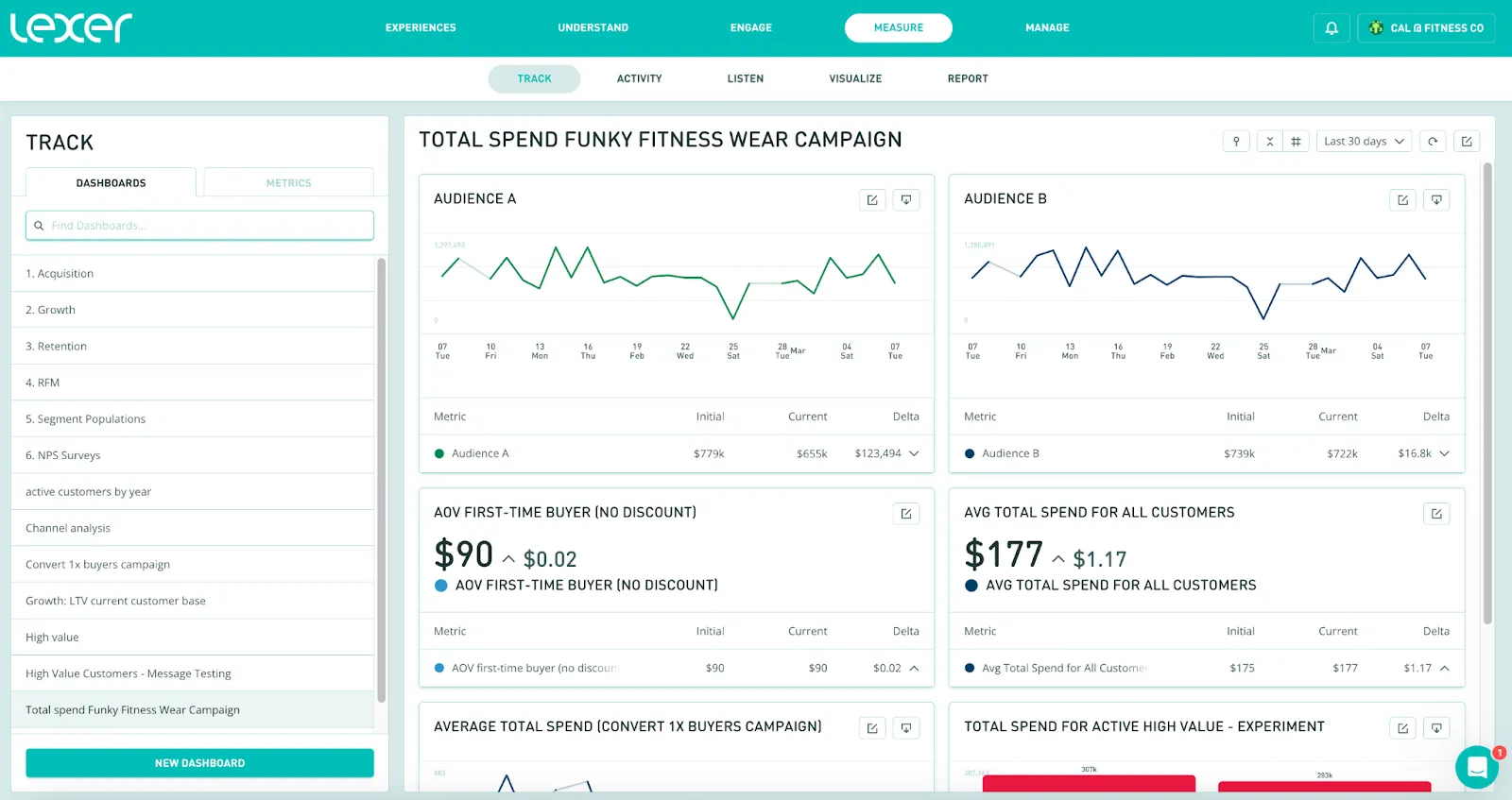
- Combine insights from multiple sources: if you send transactional data to your Email Service Provider (ESP), the ESP will provide you with revenue per email. If you haven’t set up your ESP integration yet, you can search for your ESP on our integrations page. The Track dashboards in Lexer will then help you understand the customers who have transacted, and their total value to your business (vs just the email itself).
What next?
For more information about Track, we have some great additional information on Learn. Best of luck on your Track journey, you’ll be measuring your campaign success like a Lexer legend in no time!

